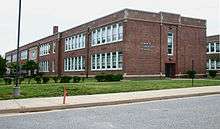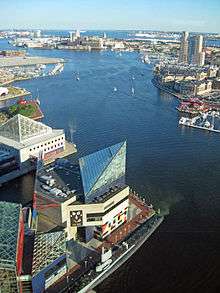Dundalk, Maryland
| Dundalk, Maryland | ||
|---|---|---|
| Census-designated place | ||
|
The Dundalk Shopping Center, in May 2006. | ||
| ||
 Location in the U.S. state of Maryland | ||
| Coordinates: 39°15′57″N 76°30′19″W / 39.26583°N 76.50528°WCoordinates: 39°15′57″N 76°30′19″W / 39.26583°N 76.50528°W | ||
| Country | United States | |
| State | Maryland | |
| County | Baltimore | |
| Founded | 1856 | |
| Area | ||
| • Total | 17.4 sq mi (45.0 km2) | |
| • Land | 13.1 sq mi (33.8 km2) | |
| • Water | 4.3 sq mi (11.2 km2) | |
| Elevation | 16 ft (5 m) | |
| Population (2010) | ||
| • Total | 63,597 | |
| • Density | 3,700/sq mi (1,400/km2) | |
| Time zone | EST (UTC-5) | |
| • Summer (DST) | EDT (UTC-4) | |
| ZIP code | 21222 | |
| Area code(s) | 410 | |
| FIPS code | 24-23975 | |
| GNIS feature ID | 0590117 | |
Dundalk (pronunciation: /ˈdʌndɔːk/ DUN-dawk or /ˈdʌndɒk/ DUN-dok) is an unincorporated community and census-designated place in Baltimore County, Maryland, United States. The population was 63,597 at the 2010 census.[1] In 1960 and 1970, Dundalk was the largest unincorporated community in Maryland. It was named after the town of Dundalk, Ireland. Dundalk is considered one of the first inner-ring suburbs of Baltimore.
History
The area now known as Dundalk was first explored by John Smith in 1608. Up until this time, the area was occupied by the tribes of the Susquehannock Indians.
In 1856 Henry McShane, an immigrant from Ireland, established the McShane Bell Foundry on the banks of the Patapsco River in the then far southeastern outskirts of Baltimore.[2] The foundry later relocated to the Patterson Park area of Baltimore until a fire during the 1940s caused it to move to 201 East Federal Street. In addition to bronze bells, the foundry once manufactured cast iron pipes and furnace fittings. When asked by the Baltimore and Sparrows Point Railroad for a name of a depot for the foundry, which was on their rail line, McShane wrote Dundalk, after the town of his birth, Dundalk, Ireland. In 1977 the foundry moved to its current location in Glen Burnie.

In 1916 the Bethlehem Steel Company purchased 1,000 acres (4.0 km2) of farmland, near the McShane foundry, to develop housing for its shipyard workers. The Dundalk Company was formed to plan a town in the new style, similar to that of the Roland Park area of Baltimore, excluding businesses except at specific spots and leaving land for future development of schools, playing fields, and parks. By 1917 Dundalk proper was founded, at which point it had 62 houses, two stores, a post office, and a telephone exchange. Streets were laid out in a pedestrian-friendly open grid, with monikers like "Shipway", "Northship", "Flagship", and "Admiral". The two-story houses had steeply pitched roofs and stucco exteriors.
The Dundalk Historic District was listed on the National Register of Historic Places in 1983.[3]
Geography
According to the United States Census Bureau, the CDP has a total area of 17.4 square miles (45.0 km2), of which 13.1 square miles (33.8 km2) is land and 4.3 square miles (11.2 km2), or 24.84%, is water.
Most of Dundalk is flat and very near sea level, with a few small hills close to the city of Baltimore to the west. Dundalk is part of the Atlantic Coastal Plain. Elevations range from sea level on the shore of the Chesapeake Bay to approximately 40 feet (12 m) above sea level along the northern reaches of Dundalk Avenue and North Point Boulevard.
Bread and Cheese Creek is a tributary of the Back River in Dundalk. The creek is 8.5 miles (13.7 km) long, with headwaters in Baltimore City. It flows through Dundalk before emptying into the Back River, which flows into the Chesapeake Bay. The watershed area of the creek is 1.85 square miles (4.8 km2).
Demographics
| Historical population | |||
|---|---|---|---|
| Census | Pop. | %± | |
| 1960 | 82,248 | — | |
| 1970 | 85,377 | 3.8% | |
| 1980 | 71,293 | −16.5% | |
| 1990 | 65,800 | −7.7% | |
| 2000 | 62,306 | −5.3% | |
| 2010 | 63,597 | 2.1% | |
| source:[1][4] | |||
As of the census[5] of 2010, there were 63,597 people. The racial makeup of Dundalk was 79.2% white, 11.0% African American, 5.0% Hispanic, 1.7% Asian, and 3.1% all other.
There were 24,772 households out of which 29.2% had children under the age of 18 living with them, 46.5% were married couples living together, 16.1% had a female householder with no husband present, and 31.5% were non-families. 26.4% of all households were made up of individuals and 13.0% had someone living alone who was 65 years of age or older. The average household size was 2.50 and the average family size was 2.98.
In the CDP the population was spread out with 23.9% under the age of 18, 7.4% from 18 to 24, 28.4% from 25 to 44, 22.6% from 45 to 64, and 17.7% who were 65 years of age or older. The median age was 39 years. For every 100 females there were 91.3 males. For every 100 females age 18 and over, there were 87.4 males.

The median income for a household in the CDP was $39,789, and the median income for a family was $46,035. Males had a median income of $36,512 versus $25,964 for females. The per capita income for the CDP was $18,543. About 6.6% of families and 9.2% of the population were below the poverty line, including 13.3% of those under age 18 and 6.9% of those age 65 or over.
Transportation
Roads
Some of the major roads in the Dundalk area are:
- Dundalk Avenue
- Eastern Avenue
- Holabird Avenue
- Merritt Boulevard
- Sollers Point Road
- Wise Avenue
- North Point Boulevard
Public transit
Public transportation between Sparrows Point, Dundalk and Baltimore City was operated by the United Railways and Electric Company's (later the Baltimore Transit Company) #26 streetcar line which ran down the middle of Dundalk Avenue until August 1958. Until the early 1950s, the line carried the famous "Red Rocket" streetcars which were two and three car trains of wooden trolleys. During World War II's rush hours on the line, trains operated on a 30-second headway.
Between 1940 and 1972, bus service in the Dundalk area was provided by Dundalk Bus Lines.[6]
Today, public transportation is provided by the Maryland Transit Administration. Four major MTA lines that serve the area are Routes 4, 10, 26 and 31.
Education

Dundalk contains a campus of the Community College of Baltimore County, known as CCBC-Dundalk. It was formerly known as Dundalk Community College.
For primary and secondary education Dundalk is served by the Baltimore County Public Schools system, with Dundalk High School, Patapsco High School, and Sparrows Point High School being the major high schools to serve the area. Dundalk is also home to Sollers Point Technical High School, one of the only high schools in the country to hold an ISO 9001 certification.
Emergency Services
Dundalk is under jurisdiction of Baltimore County Police Department, North Point (Precinct 12), which is located at 428 Westham Way.
There are multiple fire stations serving within the Dundalk area.
- Dundalk Station 6
- Eastview Station 15
- Edgemere Station 9
- Sparrows Point Station 57
- North Point-Edgemere Vol. Station 26
- Wise Avenue Vol. Station 27
Notable people
- "Nasty" Nestor Aparicio, sports writer and radio talk show host, radio station owner
- Joshua Barney, United States Navy commodore during the Revolutionary War and the War of 1812
- Mike Bielecki, former Major League Baseball pitcher
- Kevin Clash, native and resident of Dundalk's Turner Station neighborhood; performs Elmo and other Muppet characters
- Robert Curbeam, native of Turner Station neighborhood, NASA astronaut
- Ron Franklin, jockey who won the Kentucky Derby and Preakness Stakes aboard Spectacular Bid in 1979
- Rudy Gay, resident of Turner Station neighborhood; NBA player, former UConn and Archbishop Spaulding star
- Wild Bill Hagy, notable Baltimore Orioles fan
- Calvin Hill, resident of Turner Station neighborhood;[7] NFL running back, father of NBA star Grant Hill
- Jim Jagielski, open-source founder and software engineer
- Dave Johnson, former Major League Baseball pitcher
- Henrietta Lacks, resident of Turner Station neighborhood; source of the HeLa cell line
- Bucky Lasek, professional skateboarder and race car driver
- Tom Maxwell, guitarist/songwriter for rock band Hellyeah
- Greg Ottensmeyer, telecommunications pioneer.
- Douglas Purviance, Turner Station native, Grammy-winning jazz trombonist[8]
- Gina Schock, drummer for The Go-Go's
- Tony Sweet, nature photographer, jazz musician
- Jessica Williams, jazz pianist.[9]
- Bernie Wrightson, illustrator, known for his horror illustrations and comic books[10]
- Todd Allen Williams, Associated Press Award-winning journalist,[11] co-founder of ColorWolfStudio, and contributor to Vice (magazine).
References
- 1 2 "Profile of General Population and Housing Characteristics: 2010 Demographic Profile Data (DP-1): Dundalk CDP, Maryland". U.S. Census Bureau, American Factfinder. Retrieved February 22, 2012.
- ↑ McShane Bell Foundry Business Ledger Vol I (1856)
- ↑ Staff (2008-04-15). "National Register Information System". National Register of Historic Places. National Park Service.
- ↑ "Census of Population and Housing". U.S. Census Bureau. Retrieved 2009-01-28.
- ↑ "American FactFinder". United States Census Bureau. Retrieved 2008-01-31.
- ↑ Books.Google.com
- ↑ la84foundation.org
- ↑ Behind the Music: Turner Station's Douglas Purviance is a Part of History, Makes History | Dundalk, MD Patch Retrieved 2014-10-23.
- ↑ Dundalk remembers during Women’s History Month Dundalk Eagle, Retrieved 2014-10-23.
- ↑ Bernie Wrightson, illustrator - Baltimore Sun Retrieved 2014-10-23.
- ↑ "Associated Press Sports Editors contest results". Times-Tribune. Scranton Times-Tribune. Retrieved 22 August 2015.
Bibliography
- Neidt, C. (2006). Gentrification and grassroots: Popular support in the revanchist suburb. Journal of Urban Affairs, Vol. 28, No. 2, 99–120.
- Reutter, M. (2004). Making Steel: Sparrows Point and the Rise and Ruin of American Industrial Might. Urbana and Chicago: University of Illinois Press.
- Rudacille, Deborah (2010). Roots of Steel: Boom and Bust in an American Mill Town. Pantheon. ISBN 978-0-375-42368-0
- Vicino, Thomas, J. (2008). Transforming Race and Class in Suburbia: Decline in Metropolitan Baltimore. New York: Palgrave Macmillan.
External links
- http://dundalk.patch.com/ [online news and information community]
- The Dundalk Eagle newspaper
- Dundalk Chamber of Commerce
- Dundalk Renaissance Corporation
- Blue Skies Over Dundalk Maryland, blog
- Dundalk Town Center at Explore Baltimore Heritage
 |
Baltimore City | Rosedale | Middle River |  |
| Baltimore City | |
Essex | ||
| ||||
| | ||||
| Patapsco River | Sparrows Point | Edgemere |
| Rank | Name | County | Pop. | ||||||
|---|---|---|---|---|---|---|---|---|---|
 Baltimore  Columbia |
1 | Baltimore | Independent city | 620,961 | Germantown  Silver Spring | ||||
| 2 | Columbia | Howard | 99,615 | ||||||
| 3 | Germantown | Montgomery | 86,395 | ||||||
| 4 | Silver Spring | Montgomery | 71,452 | ||||||
| 5 | Waldorf | Charles | 67,752 | ||||||
| 6 | Glen Burnie | Anne Arundel | 67,639 | ||||||
| 7 | Ellicott City | Howard | 65,834 | ||||||
| 8 | Frederick | Frederick | 65,239 | ||||||
| 9 | Dundalk | Baltimore | 63,597 | ||||||
| 10 | Rockville | Montgomery | 61,209 | ||||||

